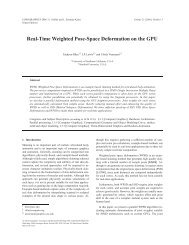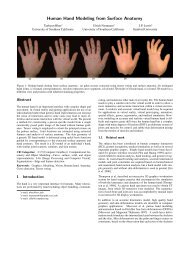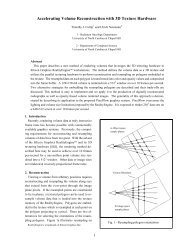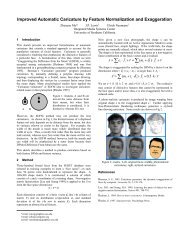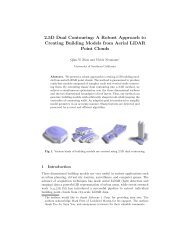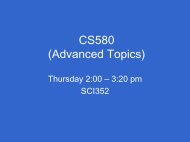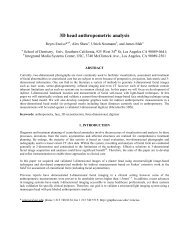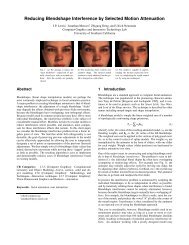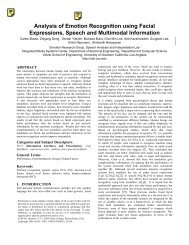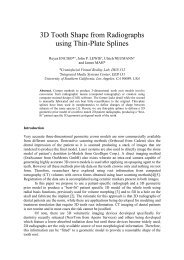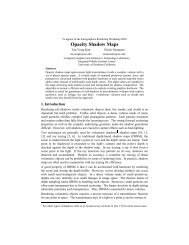Audio-based Head Motion Synthesis for Avatar-based Telepresence ...
Audio-based Head Motion Synthesis for Avatar-based Telepresence ...
Audio-based Head Motion Synthesis for Avatar-based Telepresence ...
You also want an ePaper? Increase the reach of your titles
YUMPU automatically turns print PDFs into web optimized ePapers that Google loves.
Figure 3: Illustration of the head motion synthesis pipeline. The first step is to project audio features onto<br />
the audio feature PCA space, the second step is to find K nearest neighbors in the AHD, and the third step<br />
is to solve the optimum combination by dynamic programming.<br />
that all the NEi,j, REi,j, AEi,j, ERRi,j, and P AT Hi,j are<br />
available <strong>for</strong> 1 ≤ i ≤ l − 1 and 1 ≤ j ≤ K, we move <strong>for</strong>ward<br />
to time Tl using the following equations (Eq. 7-9).<br />
err m l,j = (ERRl−1,m − Wa.AEl−1,m) + Wr.REl,j + Wa.AEl,j<br />
(7)<br />
ERRl,j = min<br />
m=1...K (errm l,j) + Wn.NEl,j<br />
(8)<br />
P AT Hl,j = arg min<br />
m=1...K (errm l,j + Wn.NEl,j) (9)<br />
Note that in Eq. 7, 1 ≤ m ≤ K and (ERRl−1,m − AEl−1,m)<br />
is used to remove the old AE, because only new AE is useful<br />
<strong>for</strong> current search. P AT Hl,j retains retracing in<strong>for</strong>mation<br />
about which neighbor is chosen at time Tl−1 if j th nearest<br />
neighbor is chosen at time Ti.<br />
Finally, the optimum nearest neighbor combination is determined<br />
by Equation 10-11. Assume S i represents the nearest<br />
neighbor optimally chosen at time Ti.<br />
Sn = arg min ERRn,j (10)<br />
j=1...K<br />
S i−1 = P AT Hi,S i 2 ≤ i ≤ n (11)<br />
Suppose T Vi,j is the T-VEC of j th nearest neighbor at time<br />
Ti, the final head pose <strong>Head</strong>P osi at time Ti (1 ≤ i ≤ n) is<br />
calculated in Eq. 12.<br />
<strong>Head</strong>P osi =<br />
i<br />
j=1<br />
T Vj,S j<br />
(12)<br />
The time complexity of this KNN-<strong>based</strong> dynamic programming<br />
synthesis algorithm is O(n. log Nd +n.K 2 ), where<br />
K is the number of nearest neighbors, Nd is the number<br />
of entries in the AHD, and n is the number of input AF-<br />
COEF, <strong>for</strong> example, if 30 head motion frames per second is<br />
synthesized and t is the total animation time (second), then<br />
n = t ∗ 30.<br />
5. CHOOSING THE OPTIMUM WEIGHTS<br />
As described in Section 4, the dynamic programming synthesis<br />
algorithm uses three weights W (Wn, Wa, Wr) to influence<br />
the outcome of the chosen nearest neighbors. What<br />
are the optimum weights <strong>for</strong> this head motion synthesis algorithm?<br />
Since it is assumed that Wa ≥ 0,Wn ≥ 0, Wr ≥ 0,<br />
and Wa + Wn + Wr = 1. The searching space can be illustrated<br />
as Fig. 4.<br />
Figure 4: Illustration of the search space of the<br />
weights W (Wa, Wn, Wr).<br />
Several speech segments (from the captured data, not<br />
those used <strong>for</strong> constructing the AHD in Section 3) are used<br />
<strong>for</strong> cross-validation [27]. For each speech segment, the key<br />
head poses at the start time and the ending time are specified<br />
as the same as the original captured head poses. For a<br />
specific weight configuration, Total Evaluation Error (TEE)<br />
is defined as follows (Eq. 13):<br />
T EE(Wn, Wa, W r) =<br />
N<br />
i=1 j=1<br />
6<br />
( ˆ V j<br />
i<br />
− V j<br />
i )2<br />
(13)<br />
Where N is the number of total cross-validation head motion<br />
frames, ˆ Vi is the synthesized head pose at frame i, and Vi is<br />
the ground-truth head pose at frame i.<br />
A variant of gradient-descent method and non-sequential<br />
random search [28] are combined to search the global min-


